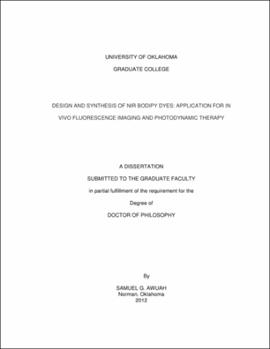| dc.contributor.advisor | Nicholas, Kenneth | |
| dc.creator | Awuah, Samuel G. | |
| dc.date.accessioned | 2019-04-27T21:30:33Z | |
| dc.date.available | 2019-04-27T21:30:33Z | |
| dc.date.issued | 2013 | |
| dc.identifier | 99250675502042 | |
| dc.identifier.uri | https://hdl.handle.net/11244/318858 | |
| dc.description.abstract | DESIGN AND SYNTHESIS OF NIR BODIPY DYES: APPLICATION FOR IN VIVO FLUORESCENCE IMAGING AND PHOTODYNAMIC THERAPY | |
| dc.description.abstract | SAMUEL G. AWUAH | |
| dc.description.abstract | 2012 | |
| dc.description.abstract | Photodynamic therapy (PDT) and fluorescence imaging are non-invasive modalities for disease treatment and diagnosis respectively. Both modalities require the use of a dye (light harvesting material) and light or source of excitation. In the case of PDT a sensitizer is needed while a fluorophore is used in the case of fluorescence imaging. PDT in addition to a sensitizer and light thrives on oxygen to generate a key cytotoxic species known as singlet oxygen. PDT has shown promise in the clinic for the treatment of surface cancers and age-macular degeneration. Fluorescence imaging on the other hand has a long history for in vitro use but a growing interest for in vivo preclinical and clinical use for diagnosis, particularly in malignancies, angiography and neurobiology. Fluorescence imaging due to its sensitivity, relatively low cost and less toxicity makes it reliable. The need to improve PDT and imaging heavily relies on the effectiveness of the sensitizer or imaging probe/fluorophore. Near infra-red (NIR) sensitizer/probes with a potential to target specific sites of interest could change the paradigm in the non-invasive modalities. | |
| dc.description.abstract | In this dissertation, the design and synthesis of NIR BODIPY for use as photosensitizers and fluorescent probes was explored. We followed a synthetic strategy of incorporating heavy atoms in the BODIPY chromophore to obtain effective singlet oxygen generating BODIPY without compromising on their optical and photophysical properties with an added advantage of red-shifting to the NIR region. We further developed a robust but versatile strategy for building fluorescent molecular probes spanning the entire therapeutic window with potential for optical imaging. We then explored the capacity to functionalize these NIR dyes for potential targeting to vectors such as peptides, antibodies, etc. We also investigated the ability of representative dyes to induce photodynamic response and to serve as optical contrast agents. | |
| dc.format.extent | 164 pages | |
| dc.format.medium | application.pdf | |
| dc.language | en_US | |
| dc.relation.requires | Adobe Acrobat Reader | |
| dc.subject | Photochemotherapy | |
| dc.subject | Fluorescent probes | |
| dc.subject | Biosensors | |
| dc.subject | Fluorescence spectroscopy | |
| dc.subject | Fluorescence microscopy | |
| dc.title | Design and Synthesis of NIR BODIPY Dyes: Application for In Vivo Fluorescence Imaging and Photodynamic Therapy | |
| dc.type | text | |
| dc.type | document | |
| dc.thesis.degree | Ph.D. | |
| ou.group | College of Arts and Sciences::Department of Chemistry and Biochemistry | |
